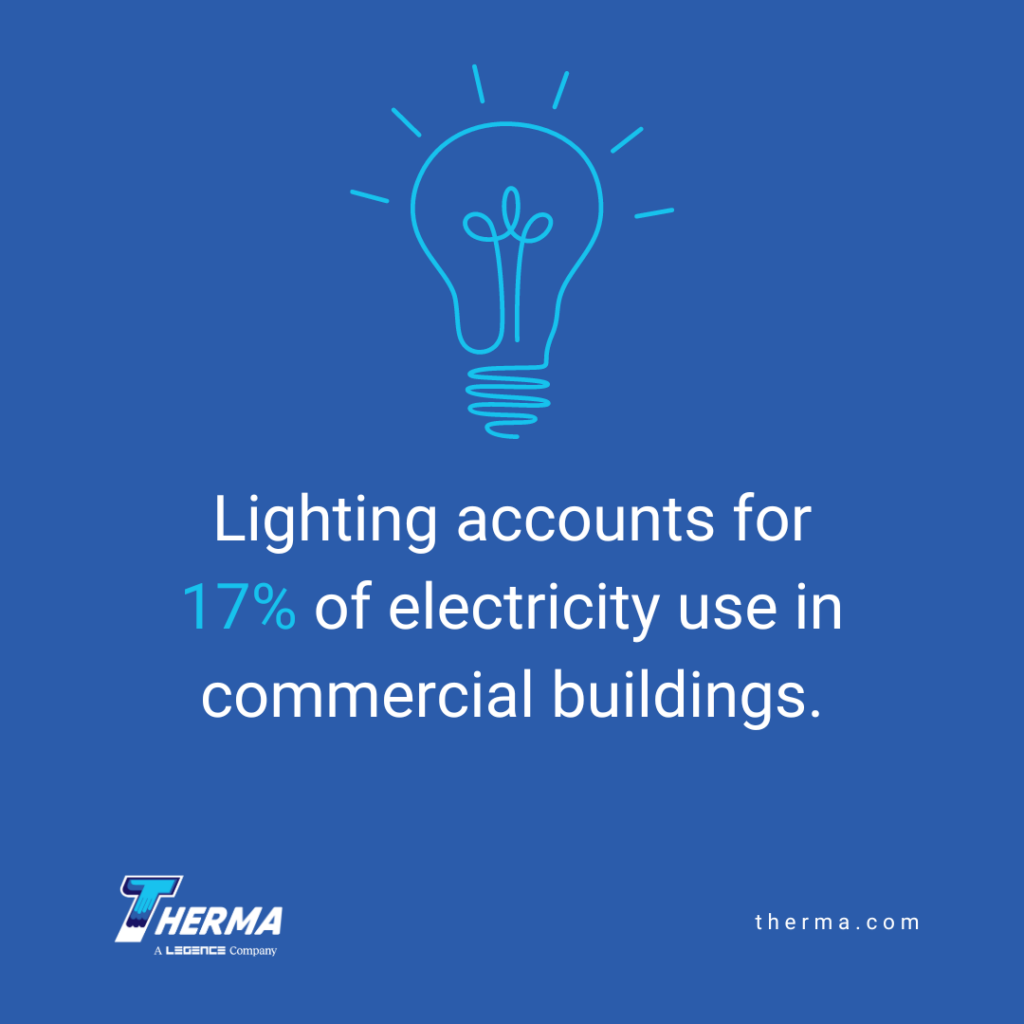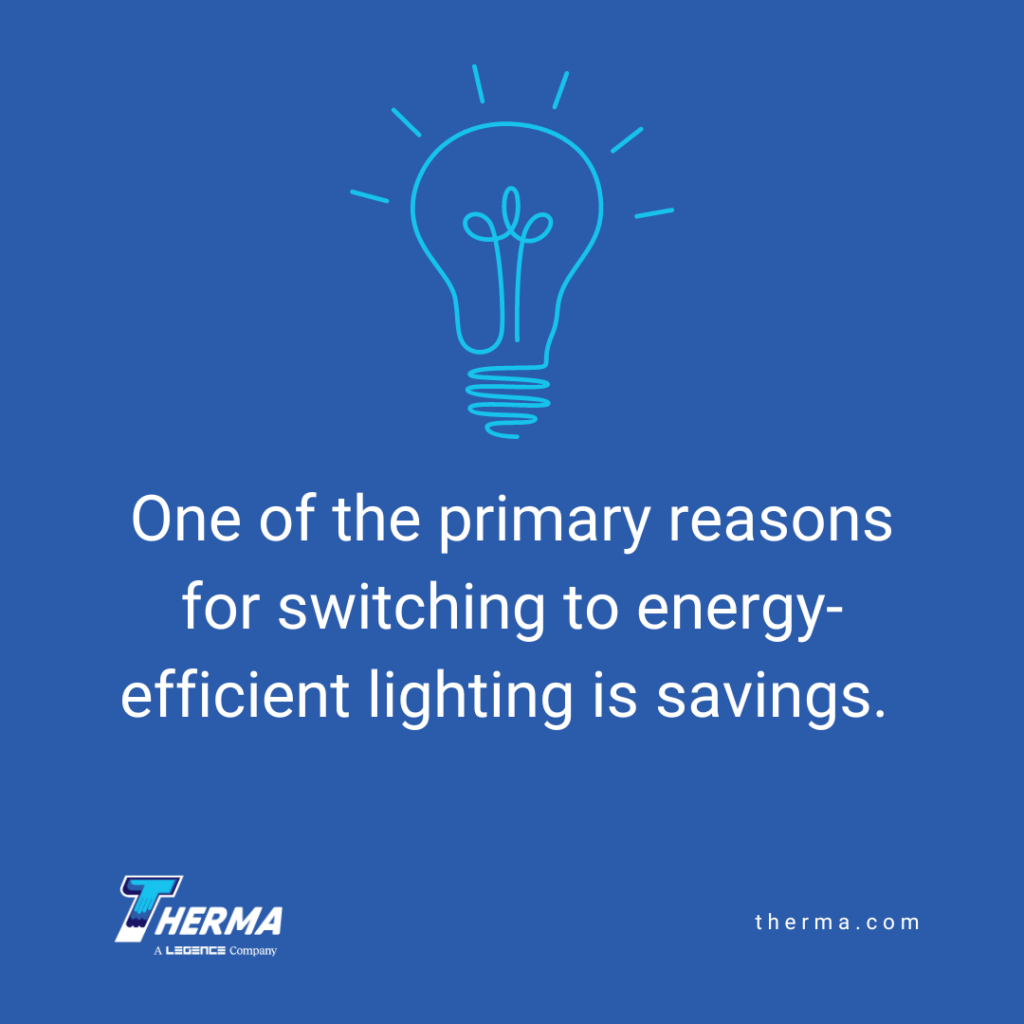by Patti Dees
Lighting accounts for 17% of electricity use in commercial buildings, making energy-efficient lighting a great way to save money. But the advantages go beyond the operations or maintenance budget. Switching to energy-efficient lighting reduces the building’s environmental impact and is a simple yet powerful way to make a difference.
Energy Efficiency Goals: Advantages to Making the Switch
One of the primary reasons for switching to energy-efficient lighting is savings. Operations and maintenance decision-makers always prefer to spend less money. Using efficient lighting reduces the power bill and trims maintenance costs. An efficient bulb uses less electricity to keep the lights on at the same brightness. As efficiency increases, there is less wasted energy and less heat generation from the bulb. Reduced heat load from lighting improves the efficiency of HVAC equipment and cuts the impact on temperature-sensitive operations, such as data centers and food storage.
Energy-efficient commercial lighting also helps meet modern code and certification requirements, as well as eligibility for rebates and incentives. From local to federal levels, governments and organizations encourage shifts to more energy-efficient buildings to reduce the number of toxic chemicals and hazardous materials used in the manufacturing and disposal of older types of lighting and to reduce a building’s carbon footprint.
But What Is Energy-Efficient Lighting?
The pursuit of energy efficiency relies on better and longer-lasting bulb technologies and fixtures. Energy efficiency gauges how much of the energy used actually creates the desired effect, in this case producing light. Lighting efficiency scales compare the brightness, heat generation, and life of the bulb.
Different types of lighting technologies are available with varying degrees of energy efficiency.
- The traditional incandescent bulb is the least efficient. Approximately 90% of the energy used by an incandescent bulb is wasted as generated heat, not light. Incandescent bulb filaments also burn out fairly quickly, lasting between 700 to 2500 hours.
- Halogen bulbs use the same technology as the incandescent bulb, with slightly better results.
- Fluorescent lights of many types are common in commercial settings. While they vary widely in performance and life span, all are more efficient than the incandescent bulb and last at least three times as long.
- High-intensity discharge (HID) lights, such as mercury vapor and high-pressure sodium bulbs, are used in arenas and in retail where there are high ceilings over large open areas. They produce very bright light and can last up to 29,000 hours. However, they do not turn on instantly, can experience significantly reduced efficiency over time, and contain toxic materials.
- The current pinnacle of energy-efficient lighting is light-emitting diodes (LEDs). Comparing this technology to the traditional light bulb, it is easy to see why. To achieve the same brightness as the incandescent bulb, LEDs use 90% less energy and generate far less heat. An LED bulb lasts about 15 times longer than incandescent bulbs and comes in different shapes and applications.
Making the Switch
Switching to energy-efficient lighting begins with an audit to locate and count each light. However, an audit also needs to assess how occupants use them. For instance, a hallway needs general lighting, but a surgical suite or a jeweler’s bench each has specific lighting needs. The choice of lighting needs to be carefully considered for such specialized uses.
Choosing the best energy-efficient lighting depends on several performance factors such as intensity or dimmability, color rendering, and optical performance.
- Intensity – Lumens needed to provide the desired brightness on a surface. Wattage indicates how much power is used, not how much light is generated.
- Dimmability – Requires both a dimmable bulb and a dimmable fixture.
- Correlated Color Temperature (CCT) – Color of the light from the LED, measured in Kelvin. Low Kelvin lights have warmer tones.
- Color rendering index (CRI) – Ability to show natural color. Daylight is at the top of the scale at 100.
- Optical performance – Refers to how the incorporated lenses and reflectors shape and direct the light.
In some cases, moving to more efficient lighting can be as simple as choosing the right bulb. However, some lighting features and designs require a synergy between the bulb and the fixture, such as dimmability. Manufacturers often include suggested bulbs or fixture types on the product packaging, which can help small-scale shifts to energy-efficient lighting. For larger buildings or those requiring specialized lighting, making the switch requires more. The professionals at Therma can maximize energy efficiency through improved design and fixture options.
Patti draws on her background as a chemical engineer to share information with readers on technology, manufacturing, and construction.
Sources and Further Reading
EnergyStar.gov – Upgrade Your Lighting | ENERGY STAR
Commercial Buildings Energy Consumption Survey (CBECS) – CBECS 2012: Trends in Lighting in Commercial Buildings
energysavingtrust.org.uk – Guide to energy efficient lighting
GB&D Magazine – 16 Benefits of LED Lighting, From Energy Efficiency to Range of Color
Department of Energy – LED Lighting | Department of Energy
Department of Energy – Lighting Choices to Save You Money | Department of Energy









